
Fleet Solutions Overview for New Fleet Managers
Fleet solutions encompass a variety of services designed to assist businesses in managing their vehicle fleets efficiently. These solutions are provided by specialized companies that


Fleet solutions encompass a variety of services designed to assist businesses in managing their vehicle fleets efficiently. These solutions are provided by specialized companies that

Preventative maintenance is designed to extend the lifespan of your vehicles, reduce the likelihood of unplanned downtime, and help avoid costly repairs.

Fleet maintenance is the most critical aspect of fleet vehicle management. By regularly servicing and inspecting each vehicle in your fleet, you can identify potential problems before they become costly repairs or lead to a breakdown on the road.

A fleet management company like PLS that specializes in fleet leasing typically offers a wide range of vehicles, including cargo vans, box trucks, delivery vans, and vehicles ready for FedEx delivery businesses.

Growing the revenue of a FedEx Ground business requires a multifaceted approach that includes increasing sales, reducing costs, and optimizing operations.

In this article, we will provide a step-by-step guide on how to start a FedEx Ground Packaging and Delivery company.
